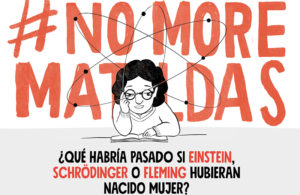Let’s conduct a little experiment. Let’s take a scientific article and go to the bibliographical references. As we know, in these references, authors are cited with their full surname and first initial. Now let’s go to the article and look for the full name of the authors. Did you catch yourself thinking of a male author only to discover that the scientist behind that initial was a woman? Welcome to the world of bias and stereotypes in the world of science. Don’t blame yourself. They were implanted in your earliest childhood. But who knows. Perhaps the next generations can be rid of them. The answer, as always, lies in education.

The technology on which wifi is based was developed by Hedi Lamarr, an actress who, however, went down in history only for her beauty.
Let us now do another exercise of imagination. Can you imagine what would have happened if Albert Einstein had been a woman? Or Alexander Fleming? Or Charles Darwin? In all likelihood, the history of science would have been very different from what it is today; and, almost certainly, those surnames would not ring a tenth of what they do now. Because the road of science is paved with the names of thousands of women whose discoveries and findings were “hidden” or attributed to male colleagues. For example, Milena Maric, Einstein’s fellow student and first wife, whose contributions to the theory of relativity are now beginning, very timidly, to be acknowledged. But also Ada Lovelace, who laid the foundations for programming languages, or Hedy Lamarr, whose research was a precursor to today’s wi-fi. The former hid her name behind initials in order to publish her ideas, and the latter went down in history as one of the most beautiful actresses in the world. The list could go on ad infinitum.
Even today, the big names in the technological revolution are still male: Bill Gates, Steve Jobs, Mark Zuckerberg… Hello? Any women in the room? Are they not interested in science? Do they lack the necessary skills? What is going on? In the following lines, we will provide some data on the current situation of girls and women in relation to STEM (Science, Technology, Engineering and Mathematics) disciplines and we will advance some of the reasons for their low participation. Finally, we will provide some possible actions that can be taken, both collectively and individually, by public and private initiative, to begin to reverse this worrying trend.
THE DATA: LACK OF ROLE MODELS, TOO MANY PREJUDICES
Let’s start with the data.
- Only 35% of students in STEM careers are women (UNESCO, 2017).
- In Europe, only 29 out of 1,000 female graduates had a degree in computer science in 2015, and only four out of 1,000 went on to pursue careers in ICT. (UNESCO, 2017).
- Enrolment rates are particularly low in ICT (3%); Natural Sciences, Mathematics and Statistics (5%), as well as in Engineering (8%). Participation is highest in health and well-being studies (15%). (UNESCO, 2017).
- Less than 5% of 15-year-old girls aspire to a career in mathematics or computer science (OECD).
- Women tend to receive more modest research scholarships than their male colleagues and, although they represent 33% of all researchers, only 12% of the members of national scientific academies are women (UNESCO, 2021).
- In cutting-edge fields such as artificial intelligence, only one out of five professionals (22%) is a woman (UNESCO, 2021).
- Despite the shortage of professionals with skills in most of the technological fields driving the so-called fourth industrial revolution, women still represent only 28% of engineering graduates and 40% of computer science and informatics graduates (UNESCO, 2021).

Graham Crouch/Banco Mundial. Licnencia CC by NCND20.
Depriving a number of disciplines, as important today as these, of the talents and potential contributions of 50% of the world’s population does not seem a very wise policy. So then the big question arises. Why? What are we doing wrong?
To answer these questions, we must pause to briefly explain a key concept. Self-efficacy. In a nutshell, self-efficacy refers to the confidence one has in one’s own abilities to cope successfully with certain situations. And how does self-efficacy relate to the issue at hand? A very clear and somewhat disturbing example: Did you know that at the age of six, girls begin to think of themselves as less intelligent than boys? So says a study in the Science journal, published in 2017.
Let’s look at more data, collected this time from the UNESCO study, Cracking the code: Girls’ and women’s education in STEM, published in 2017.
- PISA 2015 shows that girls have lower self-efficacy in science and mathematics than boys, a difference that has remained virtually unchanged since 2006.
- The same report also found that boys enjoy science more than girls in most of the participating countries (29 out of 47).
- An IDB study found that a third of students’ social media actions about women and girls in STEM were sexist, while 75% of all self-mocking messages about maths were posted by girls.
- ICILS 2013 (the study that measures ICT literacy internationally) found that in grade 8, girls scored higher than boys in all participating countries in computer and information literacy, with an average difference of 18 points. However, once again, in all participating countries, girls’ perceived self-efficacy in advanced ICT skills was significantly lower than that of boys.
And now, let’s talk about bias, also with data collected by UNESCO:
- TERCE 2013 found that, in Latin America, up to 20% of sixth grade mathematics teachers believed that mathematics was easier for boys.
- A review of studies in the USA found that teachers’ expectations of mathematics were often gender-biased, which could influence girls’ performance.
- Another study carried out in the UK and Ireland found that 57% of teachers had unconscious gender stereotypes in relation to STEM and that these gender biases can be passed on to their students through teaching.
- Classroom observations have also shown that girls are given less time in the classroom for instruction, ask fewer questions and receive less praise than boys. This was observed in a study carried out in Asia, where 65% of all teacher-student interactions in Mathematics classes were with boys, and 61% were with boys in Science.
- In some contexts, parents have lower expectations of girls’ mathematics skills and place less value on girls’ participation in Science and Mathematics.
- An analysis carried out by the UNESCO of the structure of 110 national curricula in primary and secondary school in 78 countries found that many Mathematics and Science textbooks and teaching materials express gender bias.
So, to summarise: there are studies that show, with data, that:
1. Girls think they are worse at science, despite evidence to the contrary. As a result, they do not enjoy these subjects and constantly mock their own ability in science and technology-related disciplines.
2. Teachers manifest gender biases, often unconscious, which are transmitted to their students and condition their choices and behaviours.
3. Parents also condition their daughters’ choices through their gender biases and prejudices.
4. Education systems are not blameless in transmitting gender prejudices through their textbooks and curricula.
Or to put it much more succinctly: there is a lack of role models and too many prejudices.
THE FORMULA FOR SUCCESS

The No more Matildas initiative aims to raise awareness of the lack of visibility of women scientists.
Indeed, the lack of female role models and the stereotypes associated with some technical careers are two of the most important barriers currently limiting women’s participation in science. As we have seen, it is an old story that begins in childhood, with girls who, at a very early age, begin to consider themselves less clever than boys; it develops in adolescence, with girls who exclude themselves from studies related to science and technology because they think they are not made for them, and ends with women who do not participate in the workplace or get involved in the disciplines that will shape the future of our society, thus perpetuating to infinity the biases and prejudices that give rise to this situation. Because, has anyone ever wondered why voice assistants are female and robots that win chess games look male?
What can we do about it? How do we break this vicious circle? The following are some suggestions for tackling the above-mentioned problems at their root:
- Develop girls’ confidence in their scientific abilities: girls need to be taught from the beginning that scientific abilities are not predetermined by gender and can be learned and developed.
- Encourage girls’ interest in STEM disciplines by increasing their exposure to STEM-related experiences.
- Increase the presence of women scientists in textbooks and school curricula.
- Eliminate gender bias from all school materials.
- Establish female role models: put them in contact with women scientists and technologists or female students pursuing STEM-related higher education.
- Raise awareness among parents and teachers about the vital importance of educating in equality and not transmitting gender prejudices and biases to their daughters. This can be done through talks and awareness-raising campaigns.
- Promote proactive public policies to increase the participation of girls and women in STEM education and careers.
- Develop public awareness campaigns and media partnerships to promote positive images of female STEM professionals.
- Develop agreements with scientific associations and academies to promote the presence of women among their members.
- Promote the development of specific partnerships for the creation and promotion of initiatives related to the promotion of women in STEM careers.
We are at a crucial moment to reverse a trend that has condemned half of the world’s population to remain on the margins of humanity’s great advances. Three industrial revolutions have passed us by. Let’s make the fourth one involve women. If we don’t, we risk replicating the gender gap in a loop, this time in the digital world. Let us act so that this story has a happy ending.






